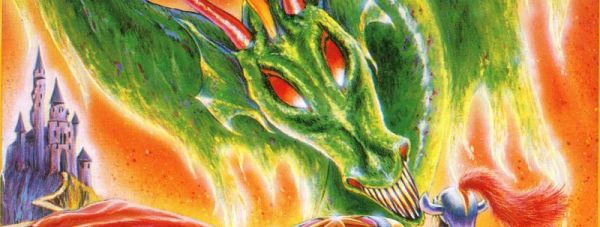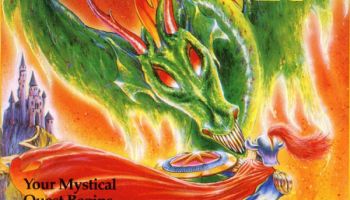
When you’re working with video games, you have to learn to be adaptable. In this edition of Bite-Sized Game History, we look at adapting in the face of a flop, adapting when you have a blockbuster fall in your lap, and adapting to the reality of creating game adaptations.
![]() You can find a lot of dedicated video game historians on Twitter, and in 280 characters or less, they always manage to unearth some amazing artifacts. Bite-Sized Game History aims to collect some of the best stuff I find on the social media platform.
You can find a lot of dedicated video game historians on Twitter, and in 280 characters or less, they always manage to unearth some amazing artifacts. Bite-Sized Game History aims to collect some of the best stuff I find on the social media platform.
By 1989, Nintendo and Enix had released three wildly successful games in the Dragon Quest series in Japan. But they ran into more than a few problems when they decided to bring the first game in the franchise to the US.
First, the two companies were forced to call it Dragon Warrior due to the existence of a tabletop RPG, which was published by TSR, that used the original name. Then, after it launched to poor sales, they realized that NES owners weened on Super Mario Bros. and The Legend of Zelda were mostly unfamiliar with the rhythms of PC RPGs like Wizardry and Ultima.
Nintendo responded to this setback by filling the pages of Nintendo Power with strategies and tips for the game in hopes of enticing their readers to try it out. But even this all-out blitz wasn’t enough to move more copies of Dragon Warrior.
So an even more radical strategy was devised within the halls of Nintendo… just give the game away.
Towards the end of 1990, Nintendo offered a free copy of Dragon Warrior to anyone who signed up for a Nintendo Power subscription. And sign up they did. Thanks to the giveaway, Nintendo Power received an influx of nearly 500,000 new subscribers. That meant that a lot of NES owners, myself included, sat down to their very first taste of the RPG genre shortly after receiving their first issue. Sure, the package also included a hint guide and a massive fold-out map, but what if you were still stuck? Thankfully, the Nintendo Game Play Counselors at the Nintendo Power Hotline were there to help.
It was an immense undertaking for the hotline’s staff, and the volume of calls they received about Dragon Warrior was relentless. And after it was all over, the staff created “I Survived Dragon Warrior” pins to commemorate this stressful stretch. The original art for the pin was recently shared by Art of Nintendo Power:
When Nintendo launched Dragon Warrior in the states, they basically sent a free copy to every Nintendo Power subscriber. Unleashing a JRPG on an unwitting public for the first time was incredibly stressful. It was all hands on deck shipping all those units, and the Counselor… pic.twitter.com/zUJ4HLLgst
— Art of Nintendo Power (@ArtofNP) June 23, 2020
Alongside Apogee Software and Epic Games, id Software was one of the pioneers of the shareware model of software distribution in the early 1990s. Famed developers such as Scott Miller and Tim Sweeney believed that they could entice new players to try out their games by giving away part of them for free. These games were often split into standalone chunks (and often referred to as “Episodes”) to make this process easier.
John Carmack and John Romero had previously used the shareware model to help promote games in the Commander Keen series and Wolfenstein 3D, but they went even further with Doom. Fans went crazy for Doom‘s launch, and the shooter’s first episode was uploaded to an FTP server at the University of Wisconsin–Madison on December 10, 1993. The demand quickly crashed the server, but that only further added to the legend that was Doom.
In the days and weeks that followed, Doom slowly worked its way into the retail pipeline thanks to a series of distributors who took the shareware episode and slapped it onto a floppy disk. But without access to the game’s iconic cover, each of these distributors had to commission their own custom artwork to go along with the disk, and some of them were absolutely wild. @vg_history recently shared a few of these designs:
doom, alternate covers, pc (1993) https://t.co/ObDO3sVrTe https://t.co/DGK0crHzxP pic.twitter.com/qdakHu0FZm
— weirdo (@vg_history) June 30, 2020
There was no shortage of licensed games in the 2000s, and many publishers looking for a unique property to adapt found an unexpected new source of material… cable television. Owing a clear debt to Grand Theft Auto, a steady stream of films from decades earlier (including The Godfather, Scarface, and Reservoir Dogs) escaped the confines of endless cable repeats and got repackaged as ultraviolent shoot ’em ups. And when they ran out of movies, the first wave of prestige television (including The Shield, The Sopranos, and 24) also served as adaptation fodder.
Though they all have their fans, the majority of these games have been long forgotten, including a few that never made it past the prototype stage. Dirty Harry, which was in development for a planned release on the PS3 and Xbox 360, was one such game that never made it past the finish line.
Dirty Harry was announced by WB Games and The Collective at E3 2005, and Clint Eastwood himself participated in a Q&A after the press conference. Hilary Goldstein, then of IGN, was one of the journalists in attendance at the event. He was seated near the back of the room while the hulking bodybuilder who played The Incredible Hulk on TV for more than a decade, Lou Ferrigno, was in the front row.
At first, Goldstein assumed that Ferrigno was playing a character in the game, but he sat there silently throughout the entire press conference. And Eastwood never “[acknowledged] or even [seemed] to realize” who Ferrigno was once the Q&A began. But as the whole thing was wrapping up, Ferrigno raised his hand, and provided Goldstein with the weirdest story of his journalism career:
I covered games for a decade and while I've seen lots of weird shit, this remains the weirdest story of my career. It involves a game that never came out and two celebrities attending an event with very different agendas.
— Hilary Thanksgivingstein (@N00bintheTube) July 3, 2020
I have to admit, I’m not sure how I’d react after hearing Lou Ferrigno ask Clint Eastwood, “Do you have concern that games like this normalize violence and create a less safe world for our children?”
Thanks to Art of Nintendo Power, @vg_history, and Hilary Goldstein for supplying these small glimpses into the past. And if you’d like to see more Bite-Sized Game History as I find it, please follow me on Twitter.

